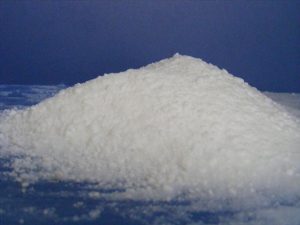FUMED SILICA
Fumed silica (CAS number 112945-52-5), also known as pyrogenic silica because it is produced in a flame, consists of microscopic droplets of amorphous silica fused into branched, chainlike, three-dimensional secondary particles which then agglomerate into tertiary particles.

Synonyms
Pyrogenic silica; XYSIL; Aerosil; Cab-O-Sil; Cabosil; silicon dioxide amorphous, synthetic amorphous silica; fumed SiO2; colloidal silicon dioxide; fumed silicon dioxide; Fumed colloidal silica;
Related Terms
Silica, fumed; silicic anhydride; ts-100 acematt, White Carbon Black
Chemical Identifiers
Linear Formula: SiO2
HS Code: 28112200, 28112290
CAS number: 112945-52-5 (hydrophilic)
MDL Number: MFCD00011232
EC No: 262-373-8
IUPAC Name: Dioxosilane
SMILES:O=[Si]=O
InchI Identifier: InChI=1S/O2Si/c1-3-2
InchI Key: VYPSYNLAJGMNEJ-UHFFFAOYSA-N
Easy way to understand fumed silica
The most common form of silica in nature is mineral quartz. The chemical formula is SiO2. When the silica heated in a frame at high temperature, it will be vaporized and then condenses, forming tiny particles of amorphous(non-crystalline) silica. (flame pyrolysis, pyrolysis method, vaporize method)
After agglomeration and deacidification, the smoke-like powder formed. That is fumed silica.
In general, fumed silica is:
- Synthetic. It does not exist in nature, only produced by human beans.
- Pyrogenic. It produced in a flame, very high temperature.
- Amorphous. It is non-crystalline silica, without a clearly defined shape or form.
- Nanoparticles. The particle size is around 7 to 40 nm.
- High Purity. The typical SiO2 content is more than 99.8% by weight.
- Powder. Unlike colloidal silica, it is in powder form.
Hydrophilic Fumed Silica
Hydrophilic fumed silica is a nanomaterial with strong hygroscopicity(absorbing moisture). This fluffy white powder is based on high purity amorphous silica. It is can be wetted by water, and dispersed in water forming a suspension.
When it firstly produced from the oxyhydrogen flame, the moisture content is very low. Take XYSIL200 for example, it is around 0.48 wt%. If exposed to air for about 30 seconds to 180 seconds, this number will be double or even tripled.
Thixotropy of Fumed Silica
The thixotropy refers to the property when the object is sheared, the viscosity becomes higher. The viscosity becomes higher when the shear stops. Thixotropy is reversible progress, presents in polymer suspensions and gel.
Fumed silica has thixotropy because of its small particle size and relatively big surface area.
In simple words, the paint/coating with fumed silica added becomes more fluid/thinner when agitated; and becomes more viscous/thickener when left still.

With thixotropy, fumed silica used as Anti-sagging agent and anti-caking(free flow) agent in paint and coating.
